When the cold winter months roll in, many species of birds fly out. Oftentimes, birds migrate south during the winter because of decreasing resources. Approximately 40% of all birds migrate. However, . plenty of non-migratory birds stay in their chosen location all year round. South Dakota is home to several of these birds. This article will provide details on ten of those non-migratory birds. At the end of the article, there is a comprehensive list of 30-plus birds that spend their winters in South Dakota.
Birds That Spend Their Winters in South Dakota
Here is a list of ten of the birds that spend their winters in South Dakota. These birds are some of the most well-known birds to people.
1. Bald Eagle
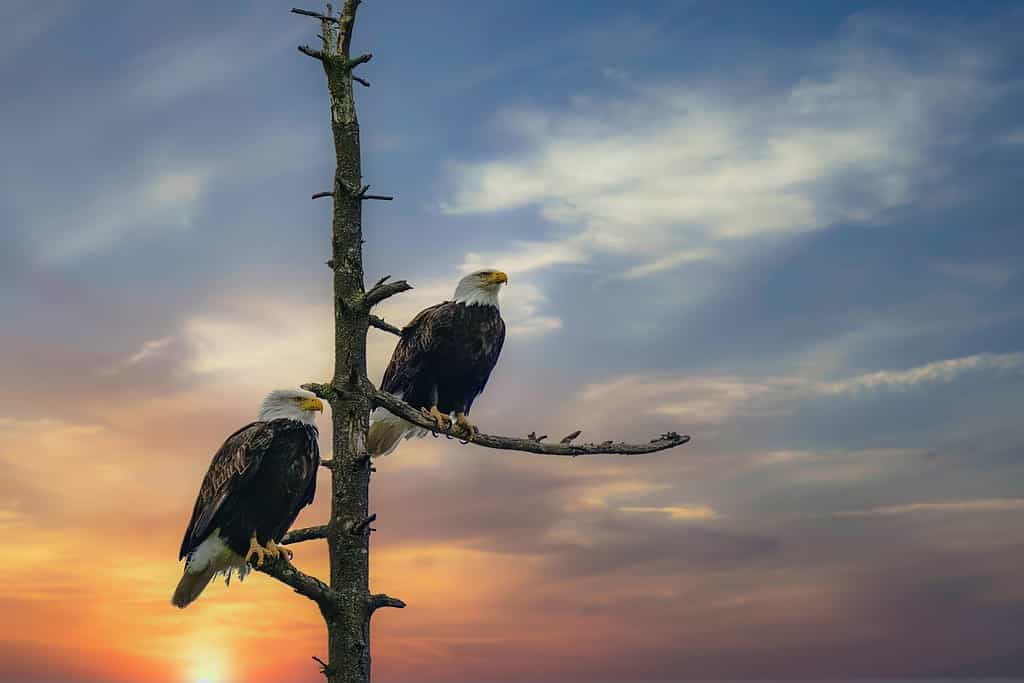
South Dakota is home to a thriving population of both nesting and wintering bald eagles.
©Wirestock/ via Getty Images
As the national bird of the United States of America, the bald eagle is easy to recognize. The bald eagle (Haliaeetus leucocephalus) is an impressive bird. Not only is this bird massive in size, reaching heights of 38 inches and weighing up to 14 pounds, but it has some incredible characteristics. For example, they have very sharp vision and a 340-degree field of view. They also have incredibly sharp talons and tiny projections called spicules that allow them to grasp their prey easily. South Dakota is home to a thriving population of bald eagles, particularly wintering bald eagles.
2. Wild Turkey

The wild turkey is an official state bird for several states.
©davidsdodd/iStock via Getty Images
Wild turkeys (Meleagris gallopavo) are commonly found in South Dakota, and not just on Thanksgiving. According to South Dakota’s Game, Fish, and Parks, “Wild turkeys are found in the Black Hills, riparian drainages with suitable woodland habitat, and in established woodland areas across the state.” Wild turkeys are non-migratory birds, meaning they take up a permanent resistance in the state and can be seen throughout the winter.
3. Northern Cardinal
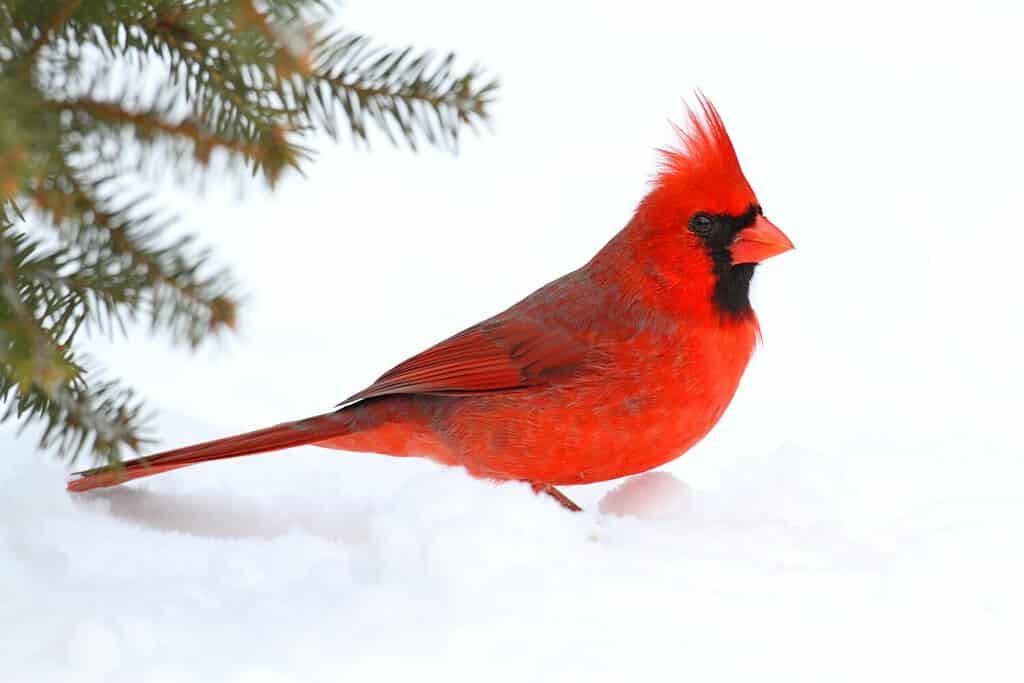
The
northern cardinal
is a permanent resident of South Dakota and is easily found in the southeastern part of the state.
©Steve Byland/Shutterstock.com
People easily recognize northern cardinals (Cardinalis cardinalis). Males of the species sport the striking bright red color, referred to as cardinal red. This medium-sized songbird is also called the common cardinal. These birds are permanent residents and easily found in the state’s southeastern part. Their habitats include riparian woodlands, parks, and suburban areas. Many people are fond of cardinals because they are said to symbolize angel messages and protection.
4. Great Horned Owl
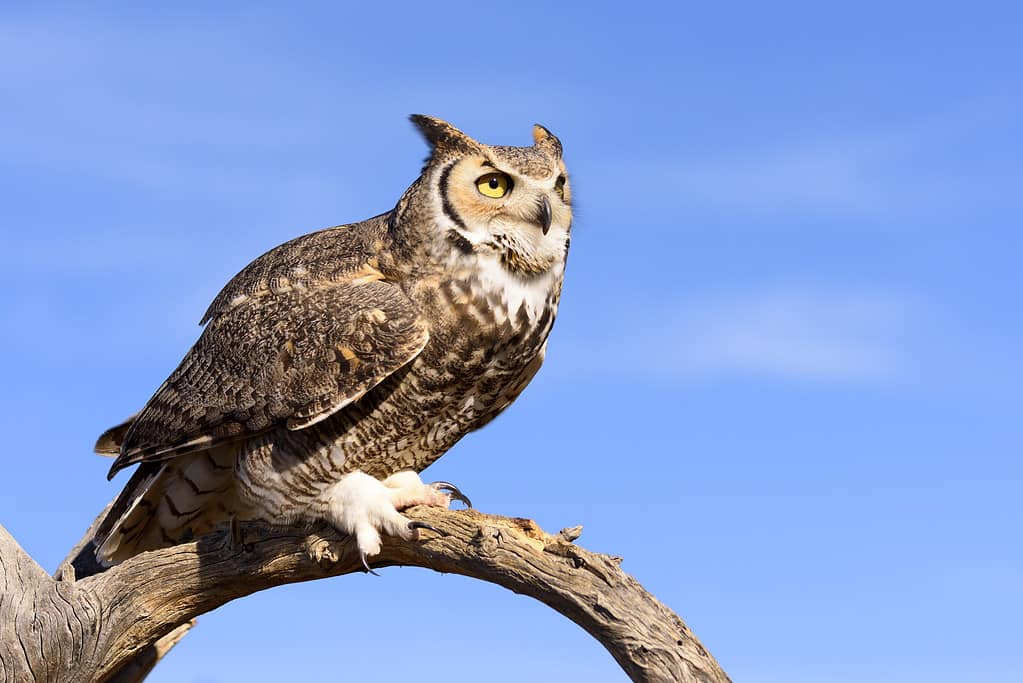
The great horned owl has small tufts made of feathers around its ears, giving it the appearance of having horns.
©kojihirano/iStock via Getty Images
The great horned owl (Bubo virginianus) is a permanent and native resident of South Dakota. It is found throughout the state and lives in woodlands, parks, forests, and in urban areas. These owls are large, reaching about 22 inches in length. They have small tufts made of feathers around their ears, giving them the appearance of having horns. Its feathers are mostly brown, with a white throat and bright yellow eyes. This species of bird is mostly nocturnal, making it more challenging for people to catch this bird in action. Great horned owls are mostly residential, meaning that they do not migrate. In South Dakota, these birds begin nesting early, laying their eggs in January or February.
5. Downy Woodpecker
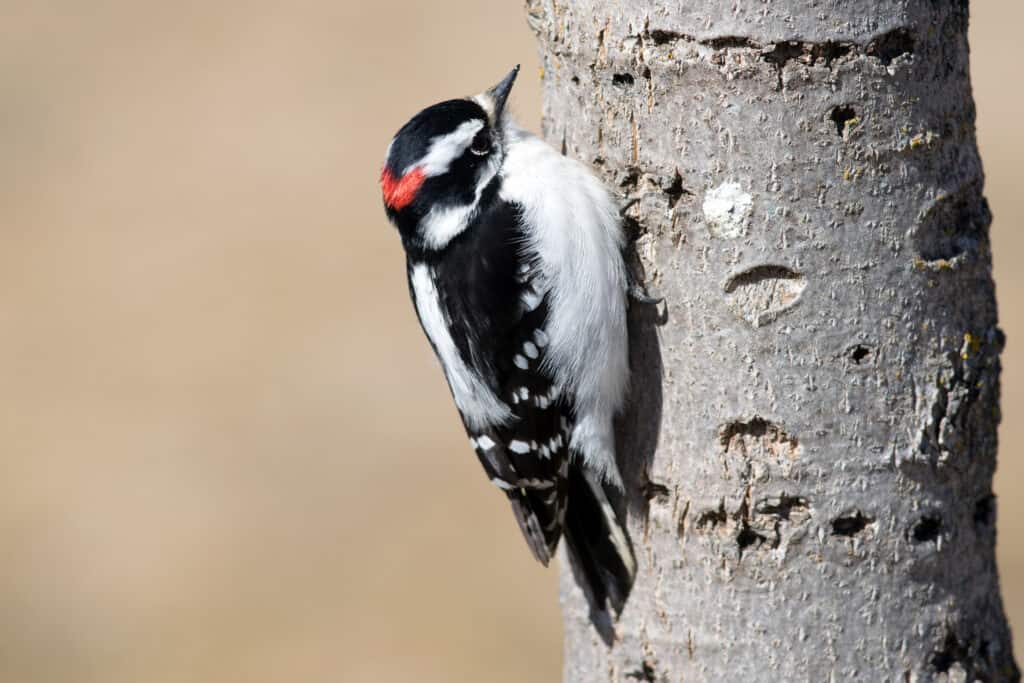
Downy woodpeckers are non-migratory birds and can be found year-round in South Dakota.
©Northernguy/Shutterstock.com
The downy woodpecker (Dryobates pubescens) is a common sight in South Dakota. They are most often found in riparian habitats. A riparian habitat, or riparian zone, is land that occurs along the edges of water sources. Those water sources could be the edges of rivers, streams, lakes, or other bodies of water. They can also often be found balancing on tiny branches of trees or balancing on people’s birdfeeders. The downy woodpecker has black and white coloring with a red patch on the back of their head. Similar to other winter birds in South Dakota, the downy woodpecker does not migrate and can be found year-round in South Dakota.
6. House Sparrow
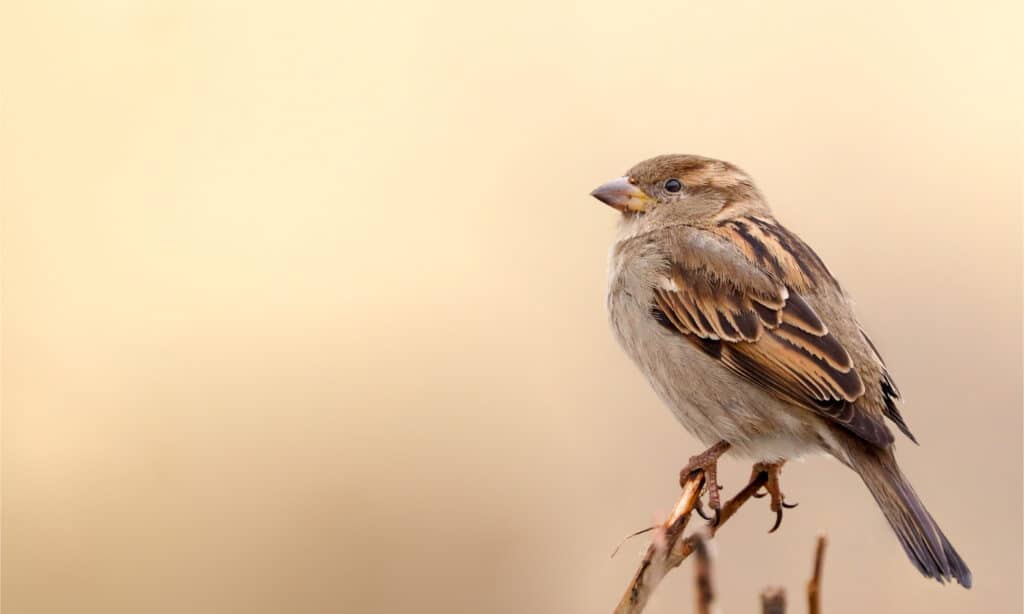
The house sparrow inhabits South Dakota during the winter months and is one of the state’s most widespread and abundant birds.
©fewerton/Shutterstock.com
The house sparrow (Passer domesticus) is recognizable not only for its appearance but because of its personality. This bird is clever, energetic, and highly sociable, making it beloved by many birdwatchers. The house sparrow inhabits South Dakota during the winter months and is one of the state’s most widespread and abundant birds. Additionally, the house sparrow is one of the most common birds in the world. This small bird is about 6 inches long with short legs, a thick bill, and pale grey plumage with brown wings. They inhibit fields, forests, urban areas, and meadows. While some species of sparrow do migrate, the majority of them —including the house sparrow — stay close to where they were born.
7. Blue Jay

People know the blue jay for its stunning appearance and its aggressive behavior.
©FotoRequest/Shutterstock.com
A distinguishable bird that spends their winters in South Dakota is the blue jay. Blue jays (Cyanocitta cristata) are songbirds native to North America that have a striking appearance. They sport blue feathers with black-tipped wings and white underbellies. While some species of blue jays migrate, some blue jays, such as those in South Dakota, remain stationary. They prefer coniferous forests as their habitat but also live in residential areas, frequenting bird feeders as well. People know the blue jay for its aggressive behavior and territorial tendencies.
8. American Crow

The American crow is known for its highly intelligent nature.
©del13/Shutterstock.com
American crows (Corvus brachyrhynchos) are commonly found throughout North America. Many cultures depict crows as bad omens, and because of that, they have been used in many horror films or stories. That is further illustrated by the fact that a group of crows is referred to as a “murder.” Another well-known characteristic of this bird is its high intelligence. The American crow is found throughout the state of South Dakota, and those who reside in this state do not migrate. They inhabit woodlands, fields, marshes, farms, and residential areas.
9. Black-Capped Chickadee
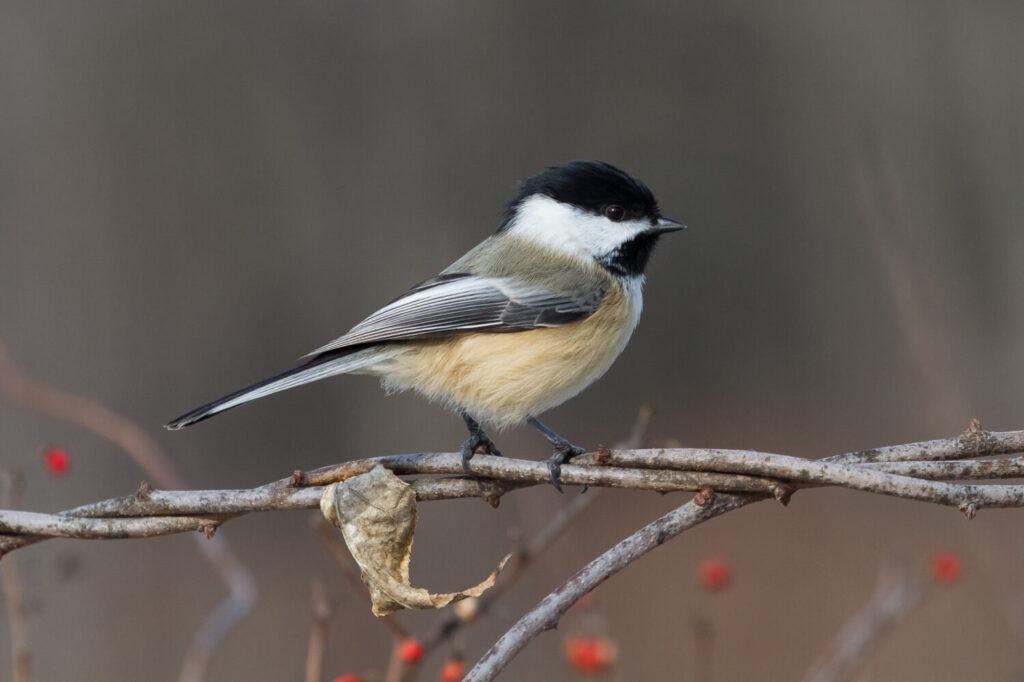
Black-capped chickadees do not migrate and can be found across South Dakota.
©Paul Roedding/Shutterstock.com
The black-capped chickadee (Poecile atricapillus) is a small, well-known songbird that inhabits North America. These birds are tiny, weighing less than half an ounce. However, despite their small size, they are easily recognizable. Bird watchers recognize this bird by its specific color pattern. The black-capped chickadee has a black head and neck and white patches on the side of its face. This bird does not migrate and can be found across South Dakota, even during the cold winter months. Black-capped chickadees inhabit forests and woodlands and often visit residential areas and parks.
10. American Goldfinch
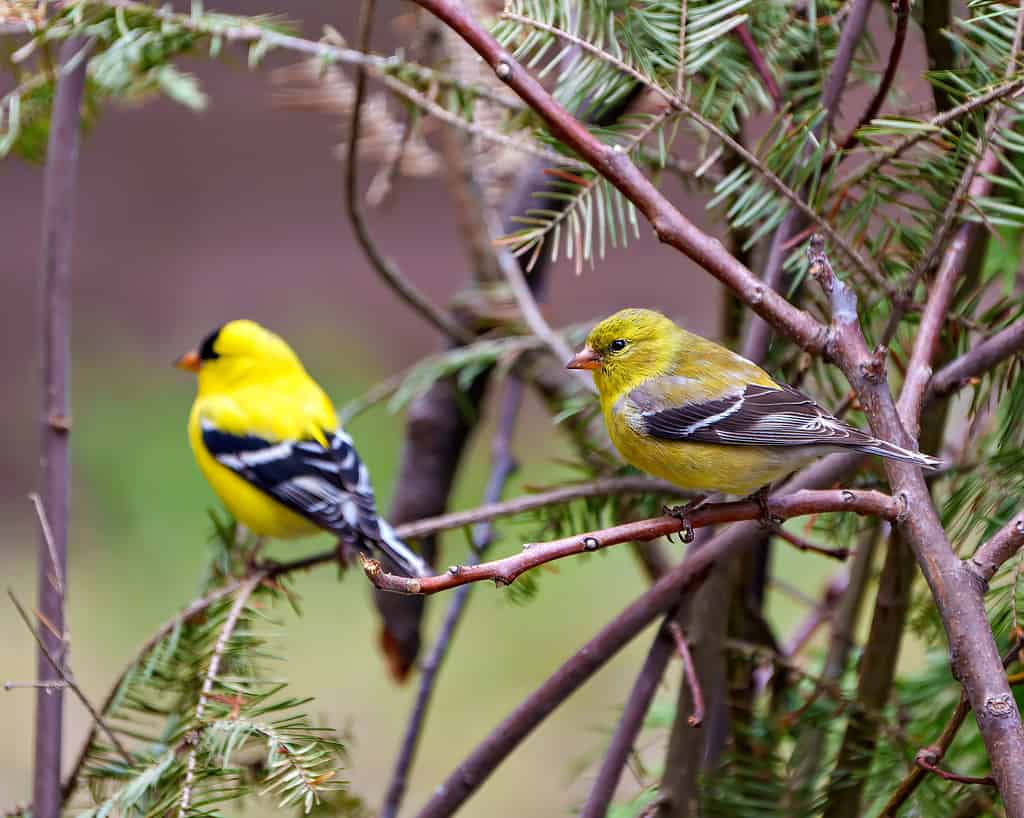
The American goldfinch only sports its bright yellow plumage during the spring and summer months.
©Rejean Bedard/iStock via Getty Images
American goldfinches (Spinus tristis) are a common North American bird. Although it is the official state bird of Iowa, the American goldfinch also inhabits South Dakota and is a common sight for birdwatchers. While American goldfinches in some northern populations do tend to migrate, those that live in South Dakota remain mostly residential. An interesting fact about this bird is that its plumage changes colors with the seasons. Their recognizable yellow plumage is only visible during the spring and summer months. During the winter, the American goldfinch is far less vibrant. Their plumage is less remarkable, with plain brown feathers and pale wing bars.
Summary of Birds That Spend Their Winters in South Dakota
| Rank | Bird Speices |
|---|---|
| 1 | Bald Eagle |
| 2 | Wild Turkey |
| 3 | Northern Cardinal |
| 4 | Great Horned Owl |
| 5 | Downy Woodpecker |
| 6 | House Sparrow |
| 7 | Blue Jay |
| 8 | American Crow |
| 9 | Black-Capped Chickadee |
| 10 | American Goldfinch |
Comprehensive List of Birds That Spend Their Winters in South Dakota
Here is a comprehensive list of birds that spend their winters in South Dakota.
- American Crow
- American Goldfinch
- American Robin
- American Tree Sparrow
- Bald Eagle
- Black-capped Chikadee
- Blue Jay
- Brown Creeper
- Canadian Goose
- Cedar Waxwing
- Common Redpoll
- Dark-eyed Junco
- Downy Woodpecker
- Eastern Screech-Owl
- Eurasian Collared Dove
- European Starling
- Evening Grosbeak
- Golden Eagle
- Great Horned Owl
- Hairy Woodpecker
- House Finch
- House Sparrow
- Horned Lark
- Northern Cardinal
- Northern Flicker
- Northern Shrike
- Pine Siskin
- Red-breasted Nuthatch
- Red Crossbill
- Ring-necked Pheasant
- Red-tailed hawk
- Rock Dove
- Rough-legged Hawk
- White-breasted Nuthatch
- Wild Turkey
The photo featured at the top of this post is © iStock.com/Diane079F
Thank you for reading! Have some feedback for us? Contact the AZ Animals editorial team.







